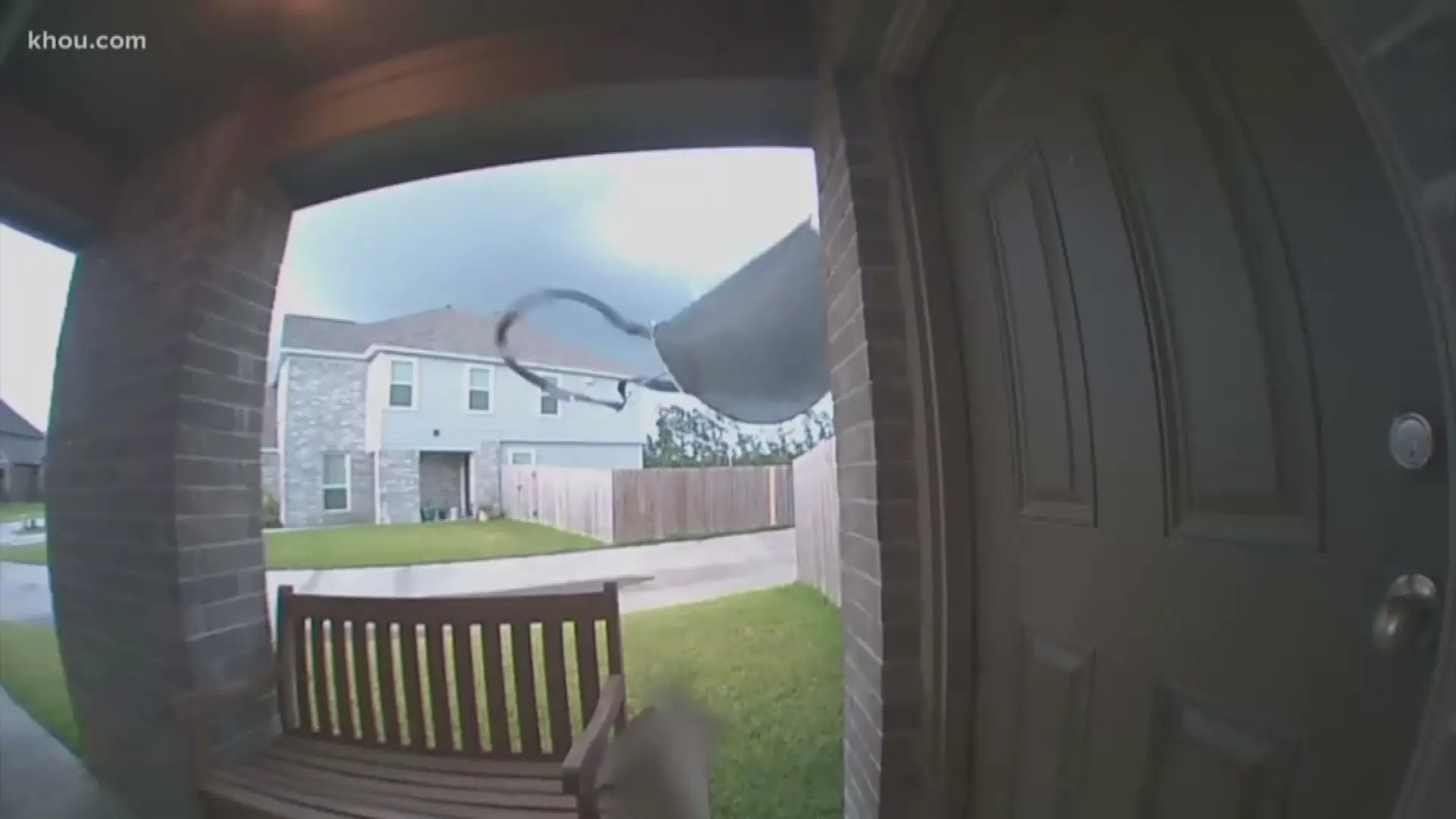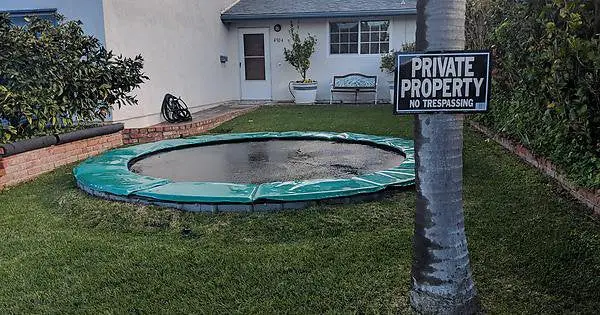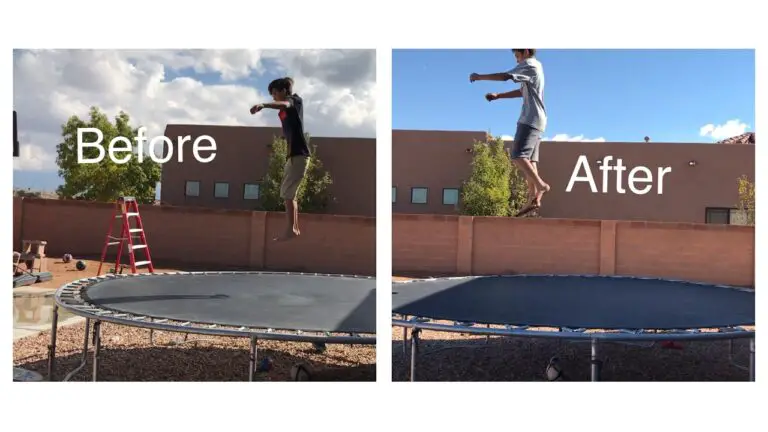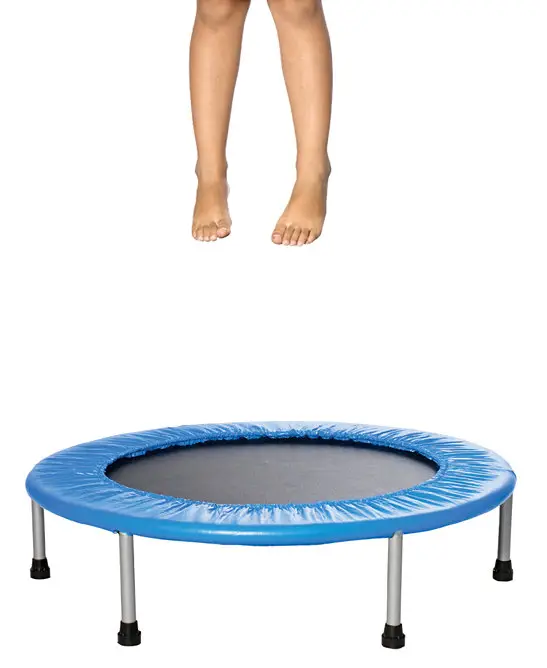When a storm is eminent, it is important to take extra measures to secure your trampoline. This will ensure that it does not become airborne and cause damage or injury. There are a few different ways that you can go about this, depending on the type of trampoline and the severity of the storm.
If you live in an area prone to hurricanes or severe thunderstorms, it is best to take precautions ahead of time and have a plan in place.
- If you have a trampoline that is not already secured to the ground, you will need to do so before a storm hits
- Use ropes or straps to tie the trampoline down to sturdy anchor points, such as fence posts or trees
- Make sure the anchors are secure and will not come loose during high winds or heavy rain
- Once the trampoline is anchored down, cover it with a tarpaulin or other waterproof material to protect it from the elements
- Secure the tarpaulin in place with more ropes or straps, and make sure there are no gaps where water could get in and damage the trampoline fabric
- Inspect the trampoline regularly during storms, and remove any debris that has accumulated on top of it
The Best Way To Anchor A Trampoline
How Much Weight to Hold down a Trampoline
If you have a trampoline that is 10 feet in diameter, you will need to weigh it down with approximately 400 pounds worth of weight. This can be done with sandbags, water jugs, or any other type of heavy object. It is important to make sure that the weight is evenly distributed around the perimeter of the trampoline so that it does not become unbalanced and tip over.
Trampoline Anchor
Trampoline anchors are an essential part of keeping your trampoline safe and secure. There are a variety of anchors available on the market, so it’s important to choose the right one for your needs. Trampoline anchors can be used to secure your trampoline to the ground, or to a wall or other structure.
Wall-mounted anchors are great for small spaces, while ground-mounted anchors are ideal for larger trampolines. When choosing an anchor, make sure it is made of durable materials and is easy to install.
Trampoline Tie down Kit
A trampoline tie down kit is an essential safety accessory for any trampoline owner. The kit includes four straps and two ratchet buckles, which are used to secure the trampoline to the ground. This prevents the trampoline from being blown away in strong winds, or tipping over if someone jumps on it too hard.
Installing a tie down kit is relatively simple. First, locate the four corner legs of the trampoline and position the straps around them. Then, thread the strap through the ratchet buckle and tighten until snug.
Repeat this process for all four corners.
Trampoline tie down kits are an inexpensive way to ensure that your family can enjoy their trampoline safely for many years to come.
How to Weigh down a Trampoline on Concrete
If you have a trampoline that needs to be weighed down on concrete, there are a few things you can do. One option is to use cinder blocks. You will need four cinder blocks for this method.
Place two of the cinder blocks on each side of the trampoline, and then put the other two cinder blocks on top of those. Another option is to use sandbags. You will need eight sandbags for this method.
Place four sandbags on each side of the trampoline, and then stack the other four sandbags on top of those.
Corkscrew Trampoline Anchor
A corkscrew trampoline anchor is a very useful device that can be used to secure a trampoline to the ground. This type of anchor is designed to screw into the ground, which makes it very easy to install and remove. Additionally, this type of anchor is also very effective at keeping a trampoline in place during high winds.
How Many Sandbags to Hold down a Trampoline
If you’re looking to keep your trampoline anchored down, you’ll need to use sandbags. But how many should you use? The answer depends on the size and weight of your trampoline.
For a small, lightweight trampoline, you’ll need 4-6 sandbags. For a medium-sized trampoline, 6-8 sandbags should suffice. And for a large or heavy-duty trampoline, 8-10 sandbags will be necessary.
Of course, it’s always best to err on the side of caution and use more sandbags than you think you’ll need. This will ensure that your trampoline stays put, even in high winds or severe weather conditions.
Trampoline Wind Stakes
If you have a trampoline in your backyard, then you know how important it is to keep it anchored down. After all, the last thing you want is for your trampoline to take off in the wind! That’s why trampoline wind stakes are so important.
Trampoline wind stakes are long, metal rods that are driven into the ground around your trampoline. They help to keep the trampoline anchored down, even in high winds. Most kits come with 8-10 stakes, which is usually enough to properly secure a standard sized trampoline.
Installing the stakes is relatively simple. First, locate the holes around the perimeter of your trampoline frame. These are typically located near where the legs attach to the frame.
Next, use a hammer or mallet to drive the stake into the ground until it’s flush with the surface. Repeat this process around the entire perimeter of your trampoline.
Once all of the stakes are in place, you can rest assured that your trampoline will stay put – no matter how strong the wind gets!
Diy Trampoline Anchor
Most people who have trampolines will eventually need to purchase an anchor kit to keep their trampoline secured. Here are some tips on how to properly install a DIY trampoline anchor:
1. Select the correct size and type of anchor for your trampoline.
The most common type is the “U-bolt” style, which attaches to the frame of the trampoline. Some models also come with a ratchet strap that goes around the entire circumference of the frame.
2. Place the anchors in strategic locations around the edge of the frame.
Make sure they’re evenly spaced out, and that each one is driven into the ground at a depth of at least 12 inches.
3. If you’re using U-bolts, thread them through all of the holes in theframe and then secure them with washers and nuts. If you’re using a ratchet strap, simply loop it aroundthe entire frame and then tighten it down until it’s snug.
4. Test your work by giving thetrampoline a good shake—it shouldn’t budge an inch once everything is tightened down!
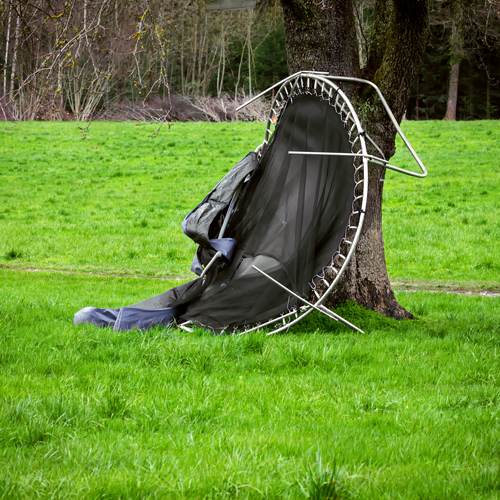
Credit: webandwarehouse.com.au
How Do You Tie down a Trampoline in a Storm?
As anyone who has ever owned a trampoline knows, they are notoriously difficult to keep in one place – especially during a storm. The wind can easily pick up the trampoline and blow it away, which is why it’s so important to know how to tie down a trampoline properly. Here are some tips:
1. Use heavy-duty straps or ropes to secure the trampoline to any nearby trees or posts. Make sure the straps or ropes are tightly secured and that there is no slack.
2. If you don’t have any trees or posts nearby, you can use stakes to secure the trampoline down.
Hammer the stakes into the ground around the perimeter of the trampoline, and then loop the strap or rope around the stake and back through itself before tying it off tight.
3. Another option is to fill sandbags with sand and place them on top of each leg of the trampoline. This will help weigh it down and keep it in place during high winds.
4. Finally, if you have an above-ground pool, you can also place your trampoline next to it and use water hoses or ropes to secure it in place (just make sure not to put too much pressure on the hose so that it doesn’t burst!).
Will Sandbags Hold down a Trampoline?
Trampolines are a great addition to any backyard, but they can be a bit of a pain to set up and take down. If you’re looking for an easy way to keep your trampoline in place, sandbags are a great option.
Sandbags are relatively inexpensive and easy to find, and they can be filled with whatever material you have on hand – sand, dirt, rocks, etc.
Simply fill the bags with your chosen material and place them around the perimeter of the trampoline. The weight of the sandbags will help hold the trampoline in place, preventing it from blowing away or being moved by strong winds.
If you live in an area that is prone to high winds or severe weather, it’s always a good idea to secure your trampoline with sandbags (or other weights).
This will help ensure that your trampoline stays where you want it and doesn’t become damaged or broken due to wind or other weather conditions.
How Much Wind Will Lift a Trampoline?
Assuming you are asking how much wind is required to lift a trampoline off the ground, the answer depends on several factors. The size and weight of the trampoline, as well as the material it is made from, will all affect how much wind is required to lift it. Generally speaking, however, it would take quite a strong wind to lift a trampoline off the ground.
How Do You Secure a Trampoline from Wind Diy?
As the weather gets warmer and summer approaches, many people will be dusting off their trampolines and getting them ready for some fun in the sun. However, if you live in an area with high winds, you may be wondering how to secure your trampoline from wind damage.
There are a few different ways that you can secure a trampoline from wind DIY style.
One option is to tie the trampoline down with rope or bungee cords. This will help to keep it in place and prevent it from blowing away. Another option is to weigh down the legs of the trampoline with sandbags or rocks.
This will help to keep it steady and prevent it from tipping over in high winds.
If you have any concerns about securing your trampoline from wind damage, be sure to consult with the manufacturer or a professional installer before taking any action on your own.
Conclusion
As most of us are now spending more time at home, many people are using this opportunity to invest in backyard improvements. One popular addition is a trampoline, which can provide hours of fun for the whole family. However, when severe weather hits, it’s important to take steps to secure your trampoline so it doesn’t become a dangerous projectile.
There are a few different ways you can do this. One is to use straps or ropes to tie the trampoline down to something sturdy like a tree or fence post. Another option is to remove the legs of the trampoline and place them inside the enclosure, filling any gaps with sandbags.
Finally, make sure there’s nothing nearby that could potentially damage the trampoline if it were to blow away, such as patio furniture or barbecue grills.
By taking these precautions, you can rest assured that your trampoline will be safe during even the worst storms.

